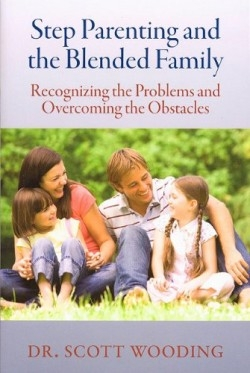Step Parenting and the Blended Family
Recognizing the Problems and Overcoming the Obstacles
Being a parent is the toughest job you’ll ever love. When you’re a stepparent, the job can be even harder. The more relationships there are to navigate within a family, the more chances for misunderstandings, resentments, and breakdowns in communication.
Luckily, Dr. Scott Wooding has written a useful, accessible book for people facing the special hurdle of step parenting. Wooding, who has thirty-five years of experience in education and psychology and has written numerous other books on child-rearing, believes that if the challenges of creating a new family are met with plenty of patience, respect, communication, and, when necessary, professional guidance, families can arrive at “the plateau when peace and harmony generally exist in the family.”
Wooding begins by addressing some of the issues that should be dealt with before remarriage is even a consideration. “Breakup baggage” includes all the hurt feelings, anger, resentment, guilt, and other poisons left behind after the dissolution of the first marriage. Not only do these have a negative impact on the emotional health of the ex-spouses, any children from the marriage will be adversely affected as well. If a person carries this emotional bundle into his or her second marriage, the effect might be devastating.
Wait, Wooding advises, possibly for years. While this may be difficult when love strikes anew, the children will benefit and the resulting family will be stronger than ever. Rushing into marriage while towing chil-dren behind could mean, eventually, another failed relationship. On the other hand, people who practice patience and strive for emotional clarity have a good chance of overcoming the miserable statistics concerning second marriages.
In further chapters, such as “Remarriage,” “Blended Families,” and “Teenagers: A Special Case,” Wooding warns newly married parents that family life won’t be all sunshine. This is one of his greatest services; when adults aren’t shocked at the anger and resentment displayed by dismayed stepchildren, they are much more likely to respond with compassion. “Their hostility is not personal,” Wooding explains. “They’re scared, confused, and angry and you present a convenient target.”
Wooding’s tone is practical and down-to-earth. His more clinical observations are sprinkled generously with case histories in which blended families both succeed and fail, according to their behaviors. Readers are invited to find wisps of themselves in these stories of other families, and perhaps discover solu-tions to their own problems alongside the subjects. He always treats his examples with respect and even manages to find humor in potentially prickly situations. When discussing discipline, consequences, and hesitancy on the part of parents, Wooding writes, “Will the child get confused? Will there be psychological damage? Nuts—just do something.” In the occasionally fraught world of blended families, this book provides a refreshingly pragmatic map to emotional minefields.
While we all hope to get it right the first time around, as Wooding points out in his introduction the chances of that are shrinking with every generation. With the right tools, however, parents and stepparents can persevere and help mend the torn ideals of the newly wedded after the cake has been all eaten up.
Reviewed by
Andi Diehn
Disclosure: This article is not an endorsement, but a review. The publisher of this book provided free copies of the book to have their book reviewed by a professional reviewer. No fee was paid by the publisher for this review. Foreword Reviews only recommends books that we love. Foreword Magazine, Inc. is disclosing this in accordance with the Federal Trade Commission’s 16 CFR, Part 255.

